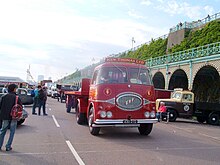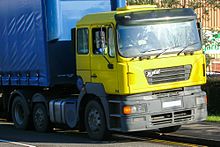ERF (truck)
ERF manufactured trucks in the UK between 1933 and 2002 , and the brand existed until 2007.
history
The company was founded by Edwin Richard Foden , the son of the British industrialist Edwin Foden, and co-founder and owner of the British truck manufacturer Foden of the same name . The name ERF is the acronym of the company's founder, so it is derived from the first letters of his name.
Edwin Richard Foden was convinced of the future of the diesel engine in commercial vehicle construction, but at the beginning of the 1930s was unable to assert himself against his colleagues from the Foden management team. He then left and founded ER Foden Ltd , ERF for short, in 1933 in Sandbach , Cheshire in Great Britain.
Were first offered Frontlenker lorry used for 6 to 7 tons of payload with diesel engines of the British manufacturer also Gardner . Three- and four-axle trucks were soon added, and trucks with two steered front axles were a specialty. Although ERF was able to continue production during World War II , the company suffered from a shortage of raw materials and had to use AEC motors instead of Gardner motors .
In 1948 a completely new generation of trucks appeared, the V series. The company founder died in 1950 at the age of 80, and his son Dennis Foden took over the management alone. The Gardner engines, which were available again, as well as the new round, cab-over-engine cabs of the KV series from 1954 with panoramic windows led to great market success. Since the mid-1950s, ERF trucks have also been available with engines from Cummins , and since the end of the 1950s with engines from Rolls-Royce . In addition to the normal range, heavier export models were also built; as an alternative to the company's own cabs, there were also external body manufacturers. In particular, ERF made great strides in improving truck brakes over the next few years and in 1958 offered front disc brakes for the first time (a technology that was not widely introduced in heavy trucks until the 1990s), and from 1962 spring-loaded brakes . With the LV series, a new model series appeared again this year. In the 1960s, Foden said goodbye to the production of hooded cars. With Peter Foden, the next generation of the founding family moved up in the company. Perkins Engines was added as a further engine supplier for ERF vehicles .
At the beginning of the 1970s, the A-series came out, the range of which extended to the maximum permitted 38-ton train in Europe (38 tonne gross vehicle weight). In 1974 it was further developed into the B series, which had a tilting driver's cab, which for the first time had components made of plastic in addition to the steel material used at the time . Fire fighting vehicles from ERF, which were built on a specially developed chassis by the subsidiary Cheshire Fire Engineering , which has since been acquired, were particularly successful in the 1970s .
At the beginning of the 1980s, a new model series was established again with the C series, again with cabs made of a steel-plastic composite construction. The truck market collapsed at the time, and ERF also felt the effects. The fire department was sold.
At the end of the 1980s, the new E-series appeared, which, as it turned out, was the last independent model range, which sold very well in Great Britain and regained lost market share. The EC models that appeared as a further development in 1993 were particularly successful and were continued again in 2000 as the ECS and ECX types.
As the last major, previously independent truck manufacturer in Great Britain, ERF was taken over in 1996 by the Canadian Western Star Group , which at the time was working with the Dutch manufacturer DAF . In 1999 the plant moved from Sandbach to Middlewich . In 2000, Western Star sold the company to the German truck and mechanical engineering group MAN . The heavy-duty trucks, which continued to be referred to as the E-series, gradually received cabs and technology from the then current MAN F-2000 series. When they were phased out at MAN, the new heavy trucks of the MAN TGA series also found their way into ERF; they only received an independent radiator cover, which still identified the vehicles for the domestic market as products from the traditional manufacturer ERF. After all, the last vehicles sold under the name ERF already fulfilled the Euro 4 emissions standard, as did their identical "brothers" from MAN. Production was relocated to the MAN truck plants in Munich and Salzgitter . The Middlewich plant survived until 2002 because a large order for medium-duty trucks was being manufactured there for the British military, after which it was closed. After MAN decided to phase out the ERF brand, the last truck with the name ERF rolled off the assembly line in Munich in July 2007 after a company history of 74 years.
literature
- Peter J. Davies: Trucks of the World - The Lexicon of Brands and Models. Motorbuch, Stuttgart 2002. ISBN 3-613-02257-5 .




